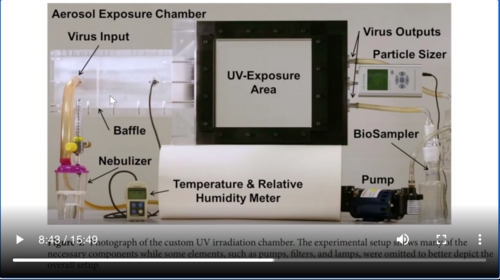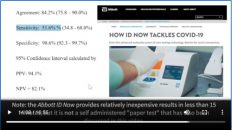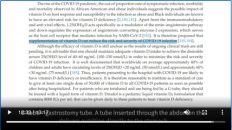Remdesivir Treatment Update and Can UV-C Disinfect Public Spaces? (Lecture 57)
本文由 ‘中国推动’ 学者、吉林大学医学院毛宗韬同学编辑整理
Welcome to another covid-19 medcram update. We got some big news for the weekend with an update on rammed a severe which we’ll get to in a moment, but I want to show you this new Johns Hopkins coronavirus resource center and the link to it will put in the description below but it has a few more features here in that in addition to critical trends. It will also give you maps of the United States were up over 2 million total confirmed.
And here’s a map of total confirmed.
Here is a map of deaths.
And this is what is shown under a tab called fatality rate.
There’s also a new tab called critical trends where you can track critical data. For instance, here, you can see where mortality rates differ across different countries and where are covid-19 cases increasing.
Over at worldometer appears as though the United States cases are leveling off.
Total coronavirus Destiny knighted states continue to rise.
Look at the United Kingdom daily new cases are also on plateau. In Canada, the number of new cases reached an all-time high.
As did the number of daily deaths in Canada.
So, I wanted to talk to you about some interesting news coming out exclusively from STAT, which is a reporting organization that looks at biotech and pharmaceutical and this was reported last night April 16. Apparently, they were able to get video footage of a conference call that was done at the University of Chicago, which is one of the centers for Gilead Remdesivir drug trial, and it’s reported here early peek at data on Gilead coronavirus drug suggests patients are responding to treatment.
As you can see this is an exclusive and we’ll go ahead and link to it, so you can read it for yourself. Now Gilead is enrolling about 2400 patients and about 125 of those patients are at the University of Chicago hospital. And what they’re doing there is they’re not doing a control arm, but in fact seeing whether or not there’s any difference whether the patient’s get 10 days or 5 days of Remdesivir infusion, so we talked about Remdesivir way back on March 9 in Coronavirus epidemic update No.33, so I really encourage you to go back and look at that video where we talked about the mechanism of Remdesivir, so we’ve kind of heard and I myself have been on the front line with patients with covid on the ventilator and I’ll tell you my experience has been the patients are not really responding very well to any kind of medication at this point. Now I have not treated anybody in the hospital with Remdesivir, so I’ve not been able to see firsthand the effects of Remdesivir.
And what they are reporting is that out of the hundred and twenty-five subjects that they have at the hospital, a hundred and thirteen of them have severe disease. Most of them are being discharged after six days and only two out of those hundred and twenty-five have succumbed to covid-19. They are reporting that fevers are going away after the first dose and that patients are being weaned off of oxygen and ventilators very quickly.
In fact, there is a report here at the end of the article. This factory worker who was admitted to the hospital on April 4th and within three days of that was discharged from the hospital almost back to normal. He says here that Remdesivir was a miracle.
And, of course, the world is waiting to find out if it is really so as well which brings up a good point. And that is we don’t have any other data that’s coming out. We don’t have the randomized Placebo controlled data stating that this thing works. The question is with these patients have gotten better without the remedy severe. It seems unlikely. But again, we really have to hold our opinions and let the data speak for itself. And so far the data has not come out yet. Of course, that has not stopped people from speculating on this.
This is a story that also came out actually referenced. The story here at STAT news which shows that the Dow Jones Industrial Average futures were up almost 900 points. We’ll see how things go on the 17th here and they also noted that Gilead shares jumped about 16.4% in after-hours trading. Of course, Gilead is the company that makes Remdesivir, not just like to say at this point that I have no stock in Gilead nor do I have any Financial relationship. And I just want to make clear again, all we have is exclusive reporting from a video of a conference at one of the sites where Remdesivir is the study drug. We do not have any official data release on this as yet. Nevertheless, It is a cause for cautious optimism.
Another area that I wanted to talk about that I think is going to have a real role and how we get this country back open again and how we get our hospitals back into shape again, so we can start doing elective surgeries and things of that nature is actually an article that was published over two years ago. And it is titled far-UVC light a new tool to control the spread of Airborne mediated microbial diseases. It almost seems as though this came out just at the right time.
So everybody knows that ultraviolet light comes from the Sun but you may not know that there are different types of ultraviolet light. There’s ultraviolet-A here. There’s ultraviolet-B here. And there’s ultraviolet-C. Now, we never actually get to see ultraviolet-C because as soon as it hits the stratosphere and comes down it essentially doesn’t get past the ozone layer, which is what this light-yellow line is. What we usually see is when it finally hits Earth as we see a lot of ultraviolet-A and we see a little bit of ultraviolet-B, and it’s really some of this A and a lot of this B although we just see a little bit of the B that causes cataracts and causes skin cancer and can cause a lot of problems. And the reason is because it can penetrate into the skin down into the growing layers of our skin tissue and mess up the DNA and cause malignancies. Now just like it is when you pull up to a stop sign or a traffic light and that car next to you is playing some really loud music. What do you typically hear? You hear the bass because the bass is able to penetrate through their car and into your car because it’s a longer wave. The shorter waves the higher sounding notes don’t penetrate as well. And that’s the same thing here. Even though this is on the shorter wavelength side of the spectrum, UV-A has a longer wavelength than UV-C and because of that, UV-A is lower in energy, UV-C is actually higher in energy but it can’t penetrate as well. So this lower wavelength can penetrate deeper into the skin. UV-B can also penetrate up to some point and it does have higher energy but it doesn’t penetrate as deeply. UV-C which is the highest in energy also known as far-UV is in the wavelength of 207 nanometers to 222 nanometers. The number to keep in mind here is 222. That should be pretty easy to keep in mind and that’s the wavelength that we’re talking about with UV-C again. We hardly ever see it on Earth naturally from the Sun. But is there another use for it? Let’s go back to that article.
Again, UV-A longer wavelength relatively, it’s less powerful but highly penetrating and responsible for the photo aging and facilitates the onset of skin cancer. UV-B is higher in energy, but it can’t penetrate as deeply and it causes a bunch of cancer in a platonic Gene stuff. Now if we were to generate UV-C here on Earth, we’re not going to get it from the sun because it’s not be able to penetrate the ozone layer, but if it were to come down, what would it do and how far would it penetrate? Let’s learn more about UV-C, especially at the wavelength of 222.
So here again, is that journal article from nature.
And what they set out to do was essentially this. Take a solution fill with influenza virus and nebulize it into a chamber. This is called the aerosol exposure chamber. And then while it was aerosolized just like for instance coronavirus would be aerosolized but they didn’t know that at the time because this was two years ago, but influenza if it was aerosolized hit it with this ultraviolet light exposure at a specific wavelength of 222 ,and then take the viral particles out and put them on a dish to see whether or not they could infect. In other words, could UV-Exposure in the far-UV District of 220 inactivate these viral particles?
So here are the results of that. And so they did it without any kind of UV-C light, what you can see here is blue being the nucleus of the cells and the small green things being the virus. So you can see clearly here that these cells are just socked in full of infected virus, then they start to turn up the amplitude on this 222 nm light and you can see here at 0.8mJ/cm2. They’ve cut down on the amounts of infections. Here at 1.3 mJ/cm2. There’s even less and finally when they crank up the amplitude to 2.0 mJ/cm2, we just see one cell that gets infected. And so, looking at that on a logarithmic scale and as we start to increase the amplitude of the energy that’s being produced. What we see here is the fractional survival go down to essentially somewhere between a tenth to a hundredth on a logarithmic scale. So about almost 90% reduction at 2.0 mJ/cm2. So, you say okay, Well, we already have this ultraviolet light in hospitals and ultraviolet light everywhere else. What’s so new about this? Why is this so good? Well, the really cool thing about UV-C especially at the 222 nm dose is it doesn’t cause any skin problems and it doesn’t cause any cataracts and the reason is because it can’t penetrate more than, well, less than a cell thickness. In other words, this uses the advantage of the fact that viruses are so small that the light has to penetrate only a small distance and it will completely eliminate and annihilate the Genome of these viruses, but it will not touch even living cells in the human body. In fact, even the tear layer on the surface of the cornea is thicker than this UV-C light can penetrate.
They say here, by contrast, we have shown earlier that far-UVC light generated by filtered excimer lamps emitting in the 207 to 222 nm wavelength range efficiently in activates drug-resistant bacteria without apparent harm to exposed mammalian skin, by the way, they do it here with influenza A which is a virus. It doesn’t matter if this is drug-resistant bacteria or just regular bacteria or drug resistant viruses or microbes it so severely disables the RNA in the DNA that the virus uses that no matter what kind of organism it is, it’s not going to live. They go on to talk about here, the approach is based on biophysical principles that far-UVC light can traverse and therefore inactivate bacteria and viruses which are typically micrometer dimensions or smaller, whereas due to its strong absorbance in biological materials, far-UVC light cannot penetrate even the outer dead-cell layers of the human skin, nor the outer tear layer on the surface of the eye. And here they showed that an H1N1 influenza A virus was inactivated and they reproduced the generated aerosol droplets of sizes similar to those generated by human coughing and breathing.
So, here’s the key in terms of opening up the country again. It says here if these results are confirmed in other scenarios, it follows that the use of overhead low level far-UVC light in public locations may represent a safe and efficient methodology for limiting the transmission and spread of airborne–mediated microbial diseases such as influenza and tuberculosis. In fact the potential use of ultraviolet light for airborne disinfection is by no means new and was first demonstrated more than 80 years ago. As applied more recently, airborne ultraviolet germicidal irradiation (UVGI) utilizes conventional germicidal UVC light in the upper part of the room with louvers to prevent direct exposure of potentially occupied room areas. This results in blocking more than 95% of the UV radiation exiting the UVGI fixture with substantial decrease in effectiveness. By contrast, the use of what they’re using here far-UVC fixtures, which are potentially safe for human exposure, they could provide the desired antimicrobial benefits without the accompanying human health concerns of conventional germicidal lamp UVGI. So, the key here is that by using the far spectrum, you can get higher energy kill the virus and it doesn’t even penetrate the outer layer of the skin.
So why don’t we already have it? All here’s an article in the Pittsburgh Post-Gazette overhead far-UVC lights could be used in any indoor location where people congregate including in hospitals, doctors’ offices, schools, airports, airplanes, trains, buses and other public spaces and could help block the spread of the Coronavirus.
And they talked about the 2018 paper that looked at far-UVC light and killing airborne viruses without harming human tissues. Here’s the key though. The two roadblocks for using this are ramping up to high capacity production and FDA approval. Mr. Brenner said, a couple of weeks ago, my best guess for both might have been nine months, but now we’re trying to go faster than that. Last month the FDA issued an advisory that clears the way for the use of sterilizer and disinfection devices, including the far-UVC lamps in hospitals and other public health settings during the unique coronavirus pandemic and prior to formal FDA approval.
This may be part of the formula that we see in terms of getting this country back on its feet and yet also making sure that we don’t go back into another epidemic and increase in cases.
So today we talked about Remdesivir, we also talked about ultraviolet radiation in the far field. It looks as though these are both promising modalities. We’re going to start to learn about the results of these ongoing trials. Trials involving other medications. Medications like hydroxychloroquine, vitamin C and numerous other drugs. And as we start to get the results of these things, it’ll become clear and in Focus exactly what it is that we’re going to need to do to battle this virus. Thanks for joining us.





Add comment